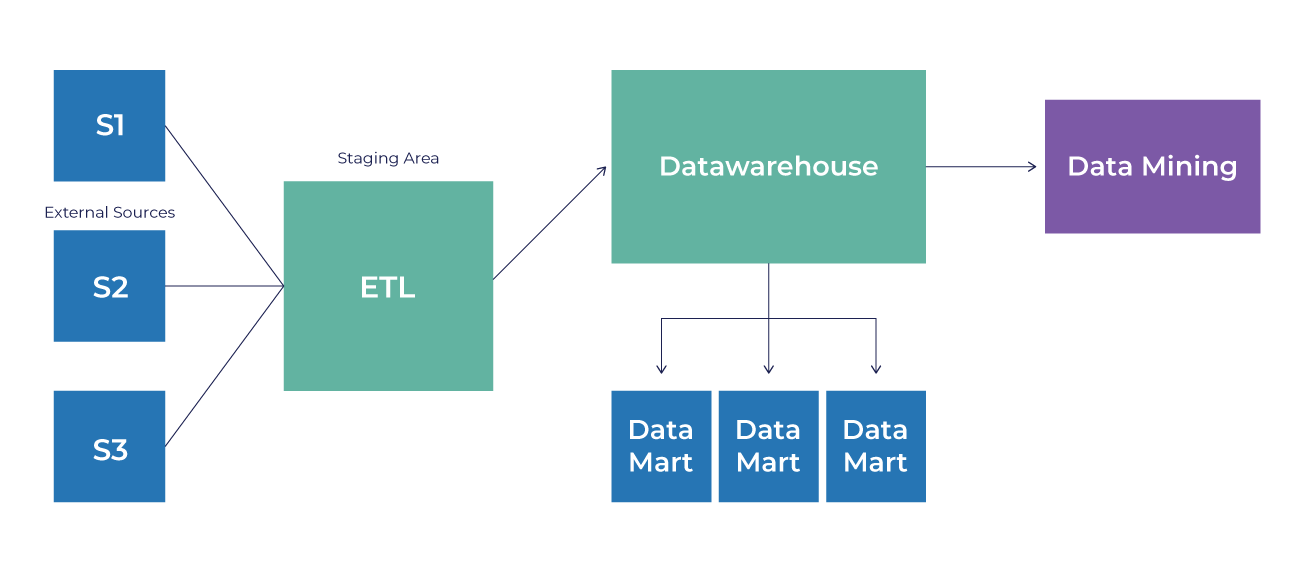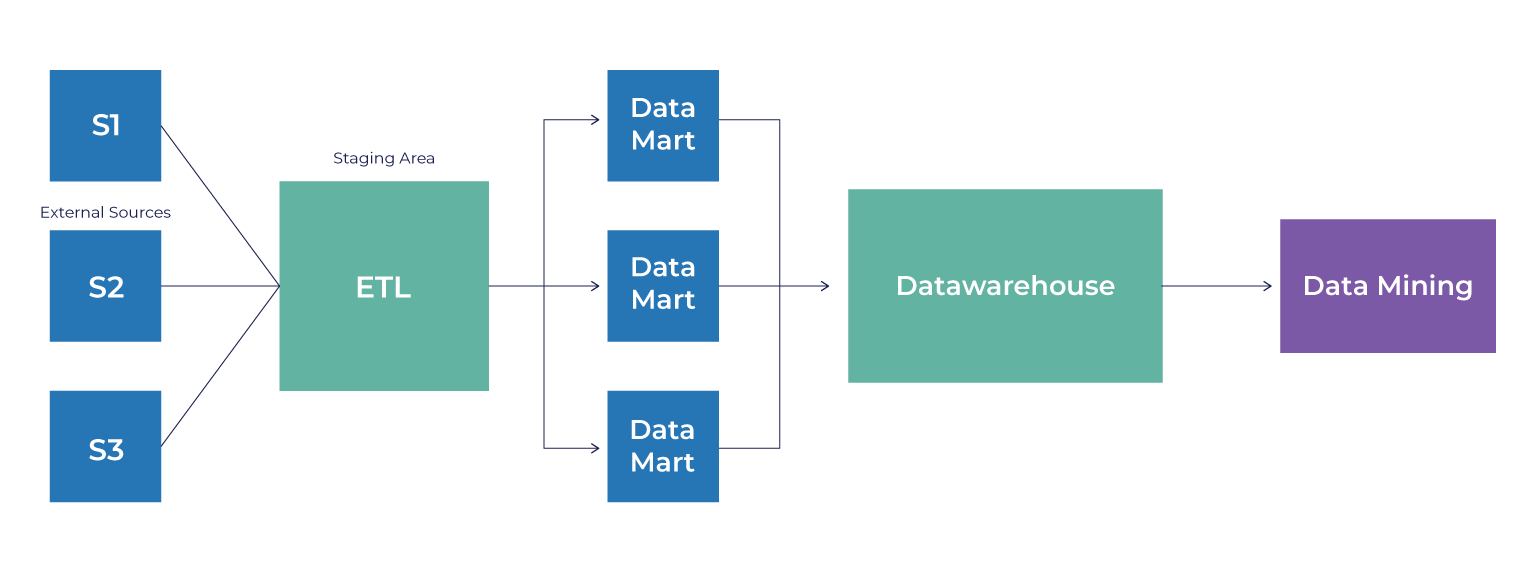In today’s data-driven world, a data warehouse has become an essential part of doing business. These single data repositories are a great option to store information coming from multiple data sources, as they allow companies to centralize data and ensure its availability for analytical processing. As beneficial as having a data warehouse can be, integrating one in your infrastructure can be a complex ordeal, especially when you’re designing it.
The data warehouse design process has countless challenges and potential pitfalls as well as ever-evolving requirements. This means that designing a data warehouse is an ongoing process to improve the way in which the system extracts, transforms, and loads data gathered from diverse sources. Given that enormous complexity, there are plenty of aspects to take into consideration before building your own data warehouse.
What Are the Key Components of a Data Warehouse?
When building a data warehouse, it’s important to think about its architecture. That’s because you need to account for the essential components of these systems so you can take better advantage of them. Here are the critical elements you need to design a data warehouse’s architecture:
- Data source layer: the sources from where you gather the data, including both internal (ERP, CRM, etc.) and external (social media, public databases, etc.) sources
- Staging area: the temporary storage where all the data you gather gets consolidated before being stored
- Data storage layer: the database where you keep the structured data and the data mart where you provide the data for analysis and reporting
- Analytics and business intelligence: the online business analytical processing tools that query, mine, and evaluate the data to build reports and visualizations
These elements can be arranged following 2 data warehouse design approaches:
Top-down approach
The data source layer sends structured, semi-structured, or unstructured data to the staging area, where all data is cleaned. After that, the clean data goes to the data warehouse and, from there, gets divided into as many data marts as particular functions in a company.

Bottom-down approach
The main difference from the top-down approach is that the clean data goes to the data marts before going to the data warehouse. This makes it quicker to get reports about specific functions, though the dimensional view of data marts isn’t as consistent as with the top-down approach.

What Are the Steps in Designing a Data Warehouse?
While not all data warehouse design processes look the same, there are several steps that are common to most of them. They’ll look different depending on the data sources, the complexity of the desired results, and the overall system complexity. However, the core steps can be summed up as follows:
Requirements definition
The first step is determining the business needs, goals, and expectations surrounding the data warehousing project.
Exploration and conceptualization
Here, the team explores the data sources and the overall security level while aiming to understand the users. Then the engineers start sketching the data warehouse, choosing the optimal architecture and the deployment type.
PlanningAfter the initial draft is done, the team goes on to properly define the project’s scope, deliverables, and roadmap, contemplating available resources, budget, and risks.
In-depth analysis of tech and data sources
Here, the engineering team dives deeper into the platforms available to build the warehousing solution. Also, developers thoroughly analyze the data sources and define the process to extract, transform, and load it into the data warehouse.
Data modeling
Here, the team chooses from one of the most common data models for the warehouse and the data marts. Options include the star, snowflake, and galaxy schemas.
Data warehouse development
After all the aspects of the project are defined and agreed upon, the engineering team starts working on the solution, connecting data sources to the databases, creating the data marts, deploying the ETL processes, and testing the entire system.
Deployment and maintenance
Once the development is done, the team launches the solution for all users, closely monitoring the performance, solving issues that might arise, and adjusting different parts to guarantee data availability, quality, and security.
Data Warehouse Design Best Practices
Given how complex designing a data warehouse actually is, it’s always a good idea for the team to keep in mind a set of best practices. By following these, the engineering team can avoid most common mistakes in this type of project while streamlining the entire development process.
- Properly define the data model. You always need to know what kind of data you’re gathering and how you can clean and store it for better analysis.
- Build a data flow diagram. Understanding where all your data repositories and data marts are and how they deal with information coming from your sources can help you refine your data-based operations.
- Use a standard data warehouse architecture. Using a well-known and tested architecture can increase your efficiency and provide you with a clearer way of maintaining and upgrading the data warehouse.
- Divide your data warehouse projects into smaller pieces. Adopting an agile methodology is key when designing a data warehouse, as you’ll be able to get faster delivery of valuable pieces of the system. Also, you’ll be able to evolve the system more quickly as your needs and data change.
- Automate your data warehousing. You can use multiple automation tools to clean data, enforce coding standards, and scale up and down.
- Consider using a cloud-based environment. You no longer need to use an on-premises warehouse for your data. Instead, you can choose one of the many cloud-based alternatives to get you going quicker and to access an increased flexibility.
Data Warehousing Schemas
The schema is the logical description of the database, which includes the name and description of all record types. Yet, data warehouses don’t use the relational model often seen in databases. Instead, data warehouses use 1 of the 3 most common schemas for warehousing, namely:
#1 Star schema
A fact table is at the center of a star-like arrangement, and it’s surrounded by as many associated dimension tables as necessary.
#2 Snowflake schema
Building on top of the star schema, the snowflake schema adds additional dimension tables to each dimension table present in a star schema.
#3 Galaxy schema
Here, there are 2 fact tables that use and share the same dimension tables.
BairesDev Helps Your Company To Create or Improve Data Warehouse Architecture
Designing a data warehouse is one of the most complex projects your company can undertake. That’s why you need the help from seasoned experts that can help you overcome typical pitfalls while providing you with a high-performing, robust, and scalable warehousing solution. In other words, that’s why you need BairesDev.
We have a team of elite Data Warehousing Experts that can help you ideate, conceptualize, design, and architect your solution. We have years of cross-industry experience delivering complex and scalable warehousing platforms that can redefine how you handle and manage your data. It doesn’t matter what type of data warehouse you’re trying to build: We can elevate its quality and provide you with the results you’re looking for.






